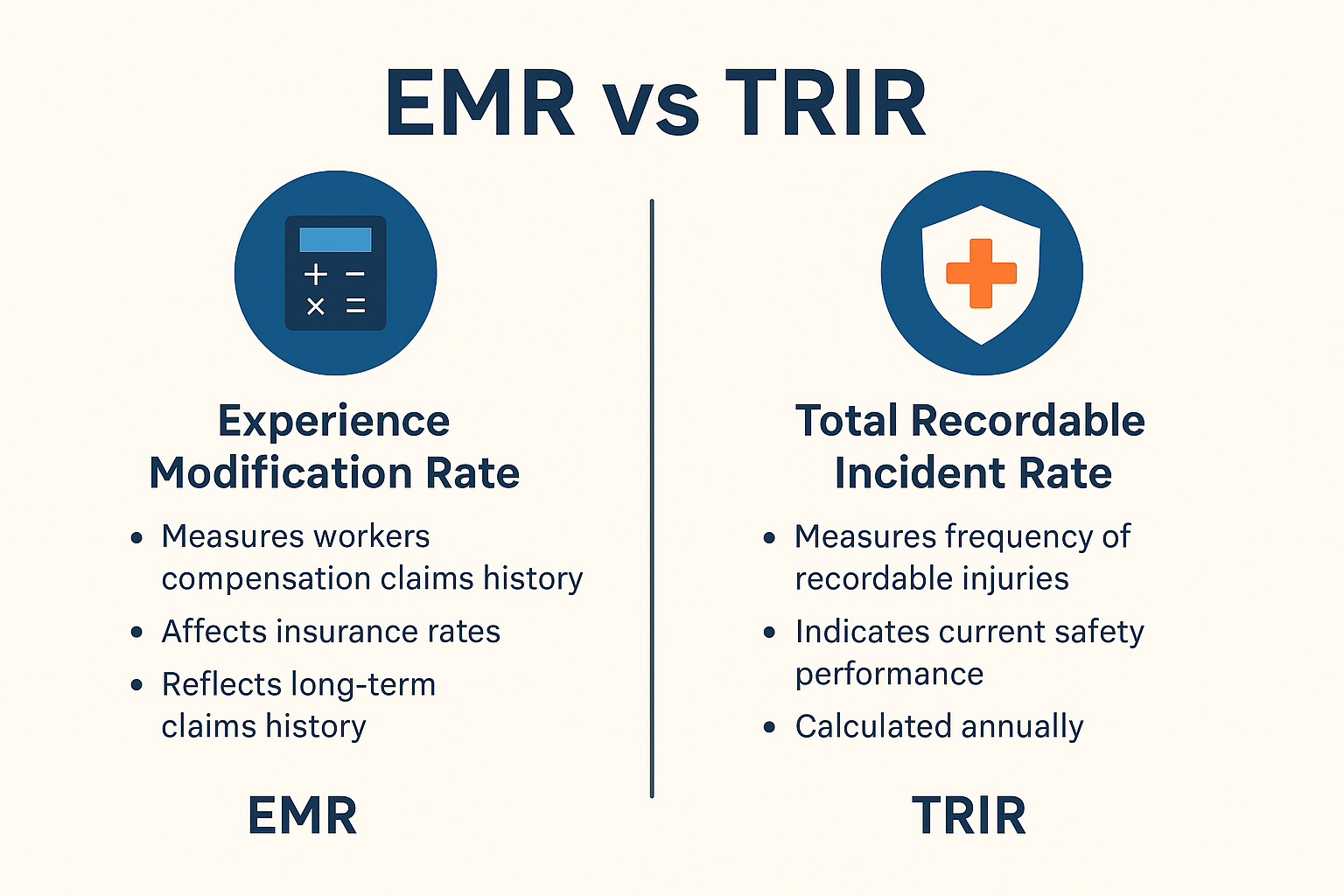Even with the best intentions, managing incidents manually leads to problems. Critical details get lost, reports are delayed, and corrective actions fall through the cracks.
The result? A cycle of similar incidents, rising incident rates, and increased regulatory exposure.
Without a structured system, even routine workplace incidents can disrupt normal operations. That’s where safety incident management software comes in.
In this guide, we’ll explore what incident management software actually does, the problems it solves, and the top four solutions to help you reduce risk and improve your safety performance.
What Is Safety Incident Management Software?
Safety incident management software is a comprehensive tool that helps organizations manage workplace incidents from start to finish.
This type of software is built to handle a wide range of incident types, such as security breaches, vehicle incidents, and workplace injuries. It also covers environmental releases, equipment failures, and other events that may disrupt normal operations.
With this tool, everything is in a single, centralized platform instead of across scattered forms, emails, or disconnected apps. This makes it easier to:
- Capture accurate incident details in real time
- Conduct root cause analysis and risk assessments
- Assign and track corrective and preventive actions
- Monitor incident trends and report on key metrics
- Align with safety regulations and regulatory compliance standards
Top 4 Safety Incident Management Software Solutions
Choosing the right safety incident management software is crucial for creating faster incident response times, improving workplace safety, and maintaining compliance.
Below are four of the best solutions you should consider.
1. MyMomentum by EHS Momentum
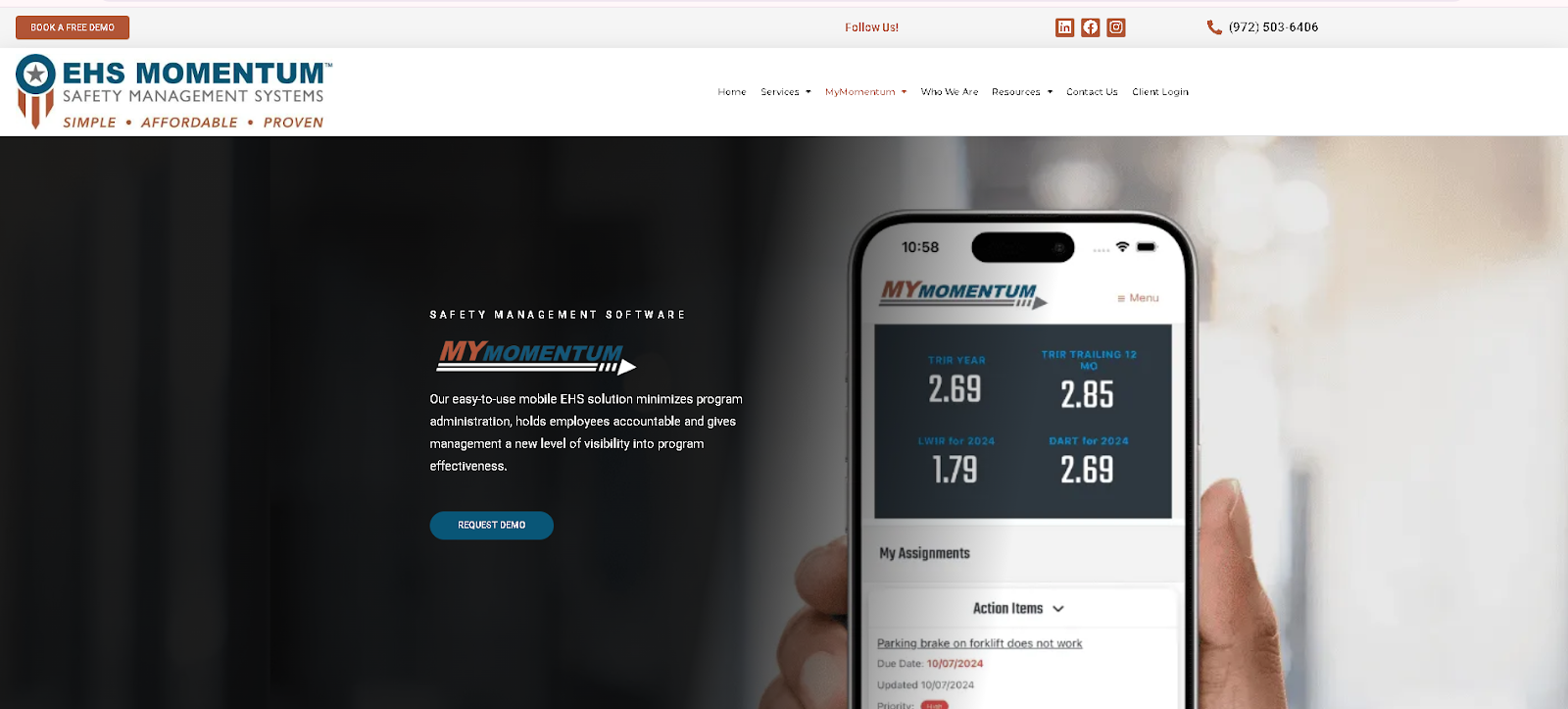
MyMomentum is designed for safety teams that need results, not complexity. Built by EHS professionals at EHS Momentum, it eliminates the frustration of paper forms, outdated systems, and platforms that frontline teams refuse to use.
Instead of adding layers of administration, MyMomentum integrates incident reporting, investigation, corrective action tracking, and compliance management into one simple, mobile-first platform.
With it, you get:
Fast, Field-Ready Incident Reporting
Report incidents immediately from mobile devices, capturing photos, time stamps, and essential context without needing to return to a desk.
Structured Investigations and Root Cause Analysis
Guide investigations through standardized workflows to make sure that hazards are identified early and controls are properly implemented.
Corrective and Preventive Action Tracking
Assign actions instantly, set due dates, track progress, and verify closeouts, all while building a complete audit trail.
Compliance Support and Documentation
Generate OSHA logs, maintain inspection records, and store completed JHAs, permits, SDSs, and safety procedures in one centralized system.
Real-Time Insights for Leaders
Automated weekly summaries and dynamic dashboards give leadership visibility into trends, unresolved risks, and improvement opportunities without manual data crunching.
Why Safety Teams Choose MyMomentum
There are plenty of reasons why organizations choose MyMomentum, such as:
- Usability that drives adoption: Field teams can complete reports and inspections quickly without special training. The system works the way people naturally work.
- Rapid deployment: Go live in days, not months. No major IT project required.
- Built for action, not just reporting: MyMomentum makes sure that every incident reported is followed through with real corrective action, and not just documented and forgotten.
- Mobile-first by design: True mobile functionality, optimized for in-the-field capture and offline access.
- Backed by EHS experts: EHS Momentum provides consulting support to help teams get more value from the platform and embed best practices into their programs.
If your team needs a practical, scalable way to modernize safety without adding an administrative burden, MyMomentum is the clear choice.
Book a demo to see how it can transform your operations!
2. VelocityEHS
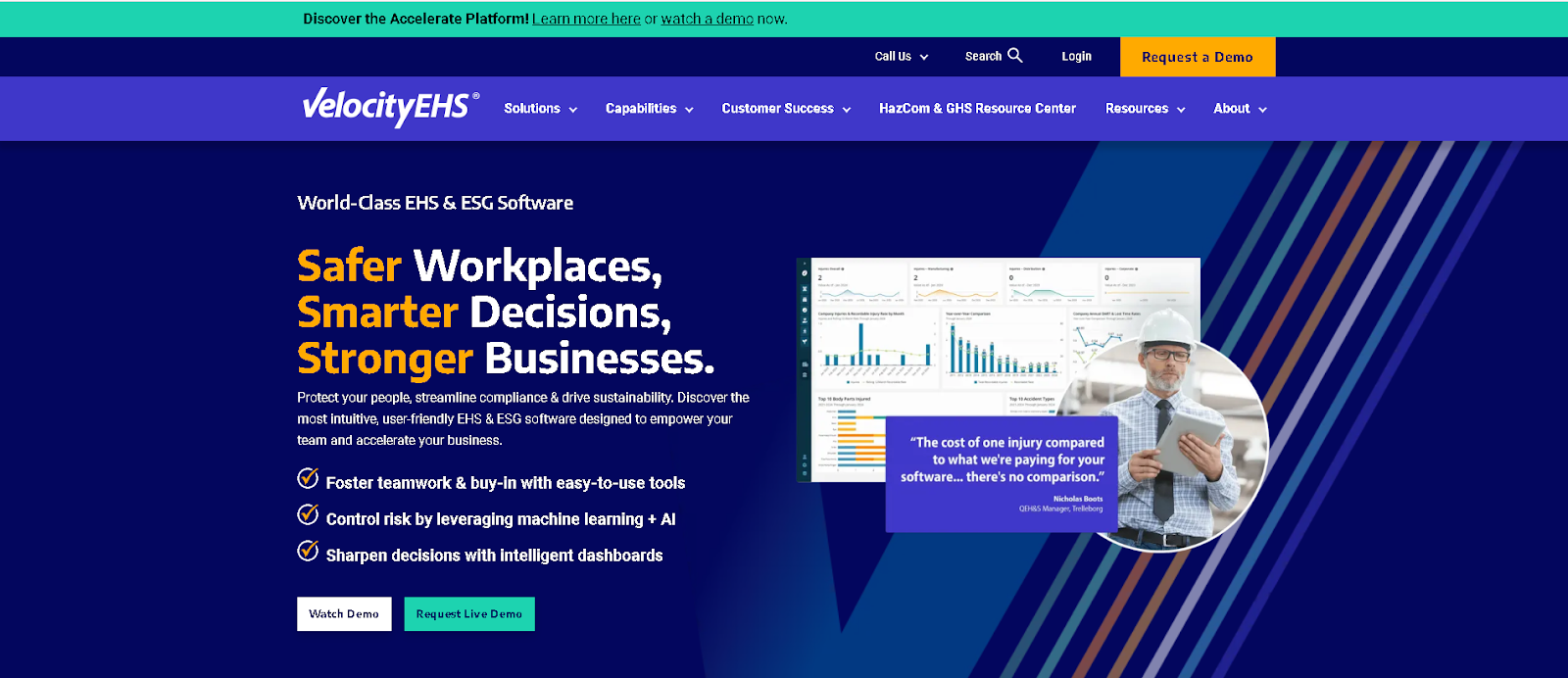
Source: EHS.com
VelocityEHS offers an enterprise-grade incident management system as part of its larger EHS platform.
Built for large organizations managing complex regulatory and operational risks, it combines incident reporting, investigation management, corrective action workflows, and compliance documentation into a highly configurable system.
Key Strengths
- Highly configurable to fit specific organizational workflows and compliance structures
- Advanced analytics and real-time trend dashboards for strategic risk management
- Strong integration with chemical management, audits, and industrial hygiene modules
- Scalable for multinational operations with regional compliance support
- Extensive documentation capabilities for audits, legal, and insurance needs
Limitations
- Complex system architecture results in a steep learning curve for new users
- Implementation can take several months and require significant IT and administrative resources
- High total cost of ownership, especially when adding custom modules or integrations
- Mobile usability is functional, but not as intuitive for frontline employees
- Best suited for organizations with a dedicated EHS department and internal system admins
3. Benchmark Gensuite
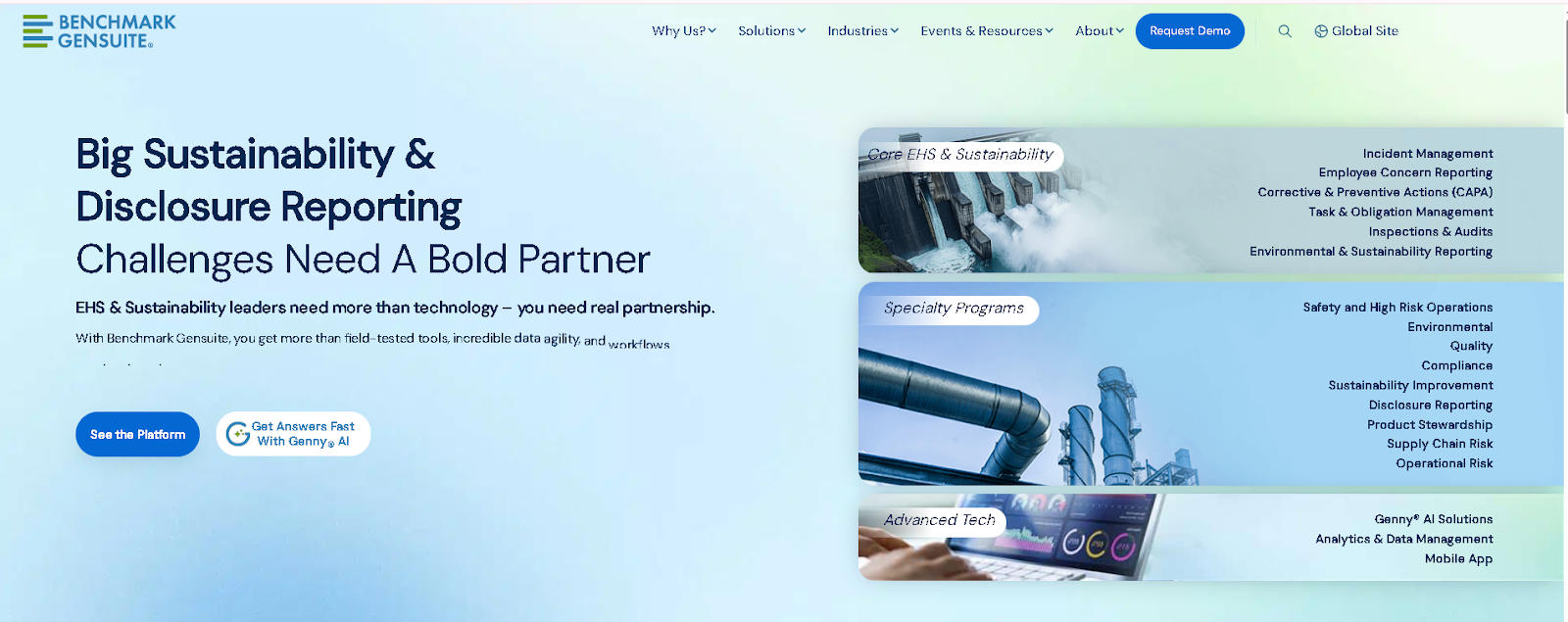
Source: BenchmarkGensuite.com
Benchmark Gensuite provides a flexible, modular platform for companies looking to build custom EHS solutions.
Its incident management software focuses on capturing, investigating, and resolving incidents efficiently while integrating with broader audit, compliance, and risk management functions.
Key Strengths
- Highly customizable workflows and incident reporting templates
- Integrated investigation tools with root cause analysis and corrective action tracking
- Robust dashboards to monitor incidents, closure rates, and time to resolution
- Supports contractor and supplier incident reporting through external portals
- Strong international compliance tracking for multinational organizations
Limitations
- Interface complexity can hinder adoption among occasional users and frontline teams
- Implementation can be lengthy, particularly with customized workflows and reporting structures
- Costs can escalate quickly as additional modules and features are added
- Configuration changes often require vendor involvement, limiting user control over system updates
- More suited to larger organizations with specialized EHS teams
4. iAuditor by SafetyCulture

Source: SafetyCulture.com
SafetyCulture’s iAuditor is a mobile-first platform focused on inspections, audits, and incident reporting.
It prioritizes ease of use and rapid deployment, making it suitable for field teams that need fast, flexible tools without the complexity of a full EHS management suite.
Key Strengths
- Easy to deploy and use, with minimal training needed
- Highly flexible form builder for customizing incident reports and checklists
- Offline functionality allows field teams to capture incidents even without connectivity
- Visual dashboards help organizations monitor basic safety trends and corrective actions
- Affordable pricing model, suitable for small to mid-sized teams and distributed operations
Limitations
- Not a full-scale incident management system; lacks built-in root cause analysis tools
- Limited structured workflows for investigations or regulatory compliance
- OSHA reporting and advanced compliance features require integrations or external add-ons
- Best for lightweight tracking rather than comprehensive incident lifecycle management
- May not meet the needs of organizations with complex or highly regulated environments
How to Pick the Right Safety Incident Management Software
Choosing the right safety incident management software is important if you want your organization to move beyond reactive reporting and toward proactive risk management.
Here’s what you should look for to support your team, drive improvement, and protect your operations.
Fast and Accurate Incident Response
Your software should make it easy for relevant personnel to capture workplace incidents the moment they happen. Mobile-enabled incident reporting allows teams to collect relevant information quickly, including photos, witness statements, and time-stamped details.
The more immediate and detailed the reporting, the better you can analyze incidents later and build effective preventive strategies.
Centralized Incident Data
A strong platform should not only record events but also organize your incident data into actionable insights. By identifying trends across locations, shifts, or job types, safety leaders can predict risk patterns and stop future incidents before they happen.
Centralized access also improves accurate reporting to meet compliance requirements and support regulatory investigations.
Support for Corrective Actions and Root Cause Management
Capturing an incident is only the beginning. The right incident management tools should allow you to assign, monitor, and track corrective actions through to completion.
Effective systems also support root cause analysis, helping you move beyond surface fixes and address the underlying factors contributing to workplace injuries and near misses.
Focus on Compliance and Continuous Improvement
Today’s organizations must balance internal safety goals with external compliance requirements. A strong incident management solution should help you maintain audit-ready documentation, meet reporting deadlines, and demonstrate global safety standards.
At the same time, it should enable ongoing learning, allowing you to gain actionable insights that refine your safety program over time.
A System That Grows With You
Whether you’re operating from a single site or expanding globally, your incident reporting software must scale. It should adapt to increasing complexity, new regulatory demands, and changing operational risks without disrupting your workflows.
The best incident management systems are flexible enough to serve both today’s needs and tomorrow’s ambitions to support improved compliance, stronger leadership visibility, and a more resilient safety culture.
How Safety Incident Software Supports EHS Program Goals
A well-run Environment, Health, and Safety program creates safer, smarter, and more resilient operations.
Safety incident management software plays a big role in achieving that by giving organizations the tools they need to achieve and deliver:
Proactive Risk Reduction
Incident management tools enable teams to spot potential hazards and patterns before they escalate into serious incidents.
With the ability to analyze trends, conduct risk assessments, and flag recurring issues, safety teams are better equipped to take preventative actions that truly reduce risk.
Compliance with Regulatory and Internal Standards
From OSHA to internal audit teams, documentation matters.
Software helps maintain regulatory compliance by centralizing records, automating regulatory forms, and making sure that tasks like investigations and corrective actions don’t slip through the cracks.
This not only helps you pass inspections, but it also shows a genuine commitment to workplace safety.
Building a Stronger Safety Culture
Timely reporting and structured follow-up create a culture where safety incidents are taken seriously and employees know their input matters.
The visibility and accountability that software enables support a more engaged workforce and a shared focus on continuous improvement.
Operational Efficiency and Cross-Team Alignment
When safety data is stored across emails, spreadsheets, and physical binders, collaboration breaks down.
A centralized platform streamlines communication between field teams, safety professionals, and leadership. This keeps everyone focused on shared outcomes and drives greater operational efficiency.
Manage Incidents Smarter, Faster, and Safer with EHS Momentum
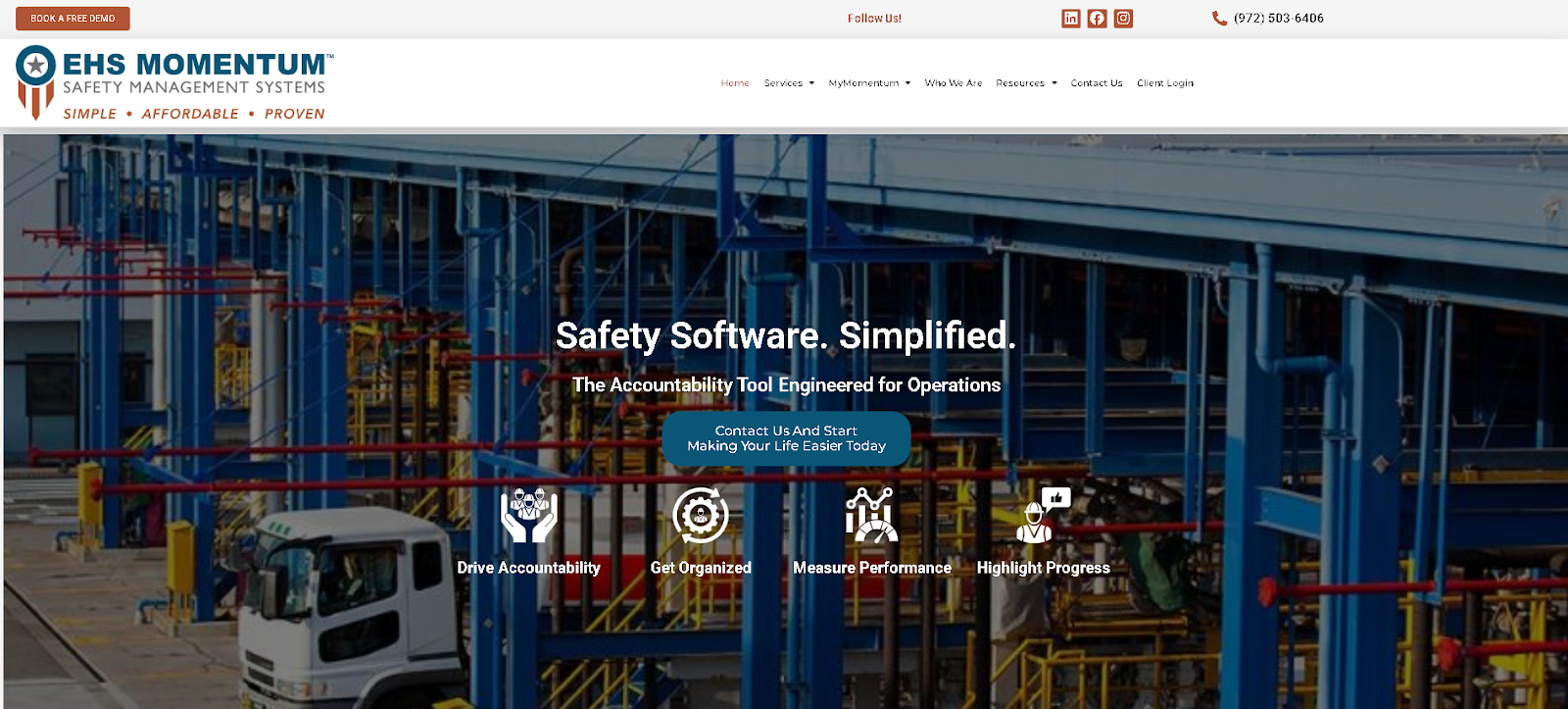
EHS Momentum helps organizations move beyond paper forms, outdated platforms, and inconsistent reporting by offering practical tools and expert support to build safer, more accountable operations.
We do this through MyMomentum, which is safety incident management software designed for real-world teams, especially those tired of clunky systems, paper forms, or tools that frontline workers avoid.
With MyMomentum, you can:
- Report incidents quickly from the field using any device
- Launch investigations with built-in tools for root cause analysis
- Assign and track corrective and preventative actions with ease
- Monitor incident activity across sites in real time
- Generate regulatory forms and documentation to support regulatory compliance
- Gain visibility into incident trends, hotspots, and unresolved risks
- Strengthen your entire incident management process while improving safety performance
MyMomentum helps your team respond faster, reduce risk, and keep your safety program running smoothly, without extra headcount or administrative headaches.
Ready to create a safer, smarter workplace? Book a demo to see how MyMomentum can transform your organization’s safety management, one incident at a time.
FAQs About Safety Incident Management Software
What is incident management software?
Incident management software is a digital tool for tracking, investigating, and resolving workplace incidents such as injuries, equipment failures, or environmental hazards.
Unlike manual processes, this software enables consistent incident reporting, structured investigations, and follow-through on corrective actions.
Modern solutions also support data collection, hazard identification, and compliance documentation. This makes it easier to manage workplace safety incidents while reducing future risk.
Many systems also integrate with third-party applications, enhancing cross-functional workflows and reporting.
What is safety incident management?
Safety incident management refers to the structured process of documenting, investigating, and responding to events that threaten the safety of workers, assets, or operations.
It includes incident reporting, identifying root causes, implementing corrective actions, and monitoring resolution.
Which tool is used for incident management?
There are many software solutions used for managing incidents, depending on the industry and the complexity of the organization’s needs.
Tools like MyMomentum are purpose-built platforms for incident management within EHS programs.
These tools help organizations streamline incident reporting, manage investigations, assign and follow up on corrective actions, and maintain documentation for audits and compliance.
The best platforms act as a comprehensive solution, covering everything from data collection to actionable insights and making sure that all workplace safety incidents are properly addressed.
Can Jira be used for incident management?
Yes, Jira, originally designed for software development and project tracking, can be adapted for basic incident management workflows. Some organizations use Jira for logging incidents, assigning tasks, and tracking resolutions, particularly in IT or software-related environments.
However, Jira is not specifically built for workplace safety or EHS-focused incident management. It lacks features like OSHA-compliant incident reporting templates, built-in hazard identification tools, and industry-aligned compliance features.
For organizations focused on environmental hazards, safety management, and EHS compliance, a dedicated incident management solution like MyMomentum is more suitable and scalable.







